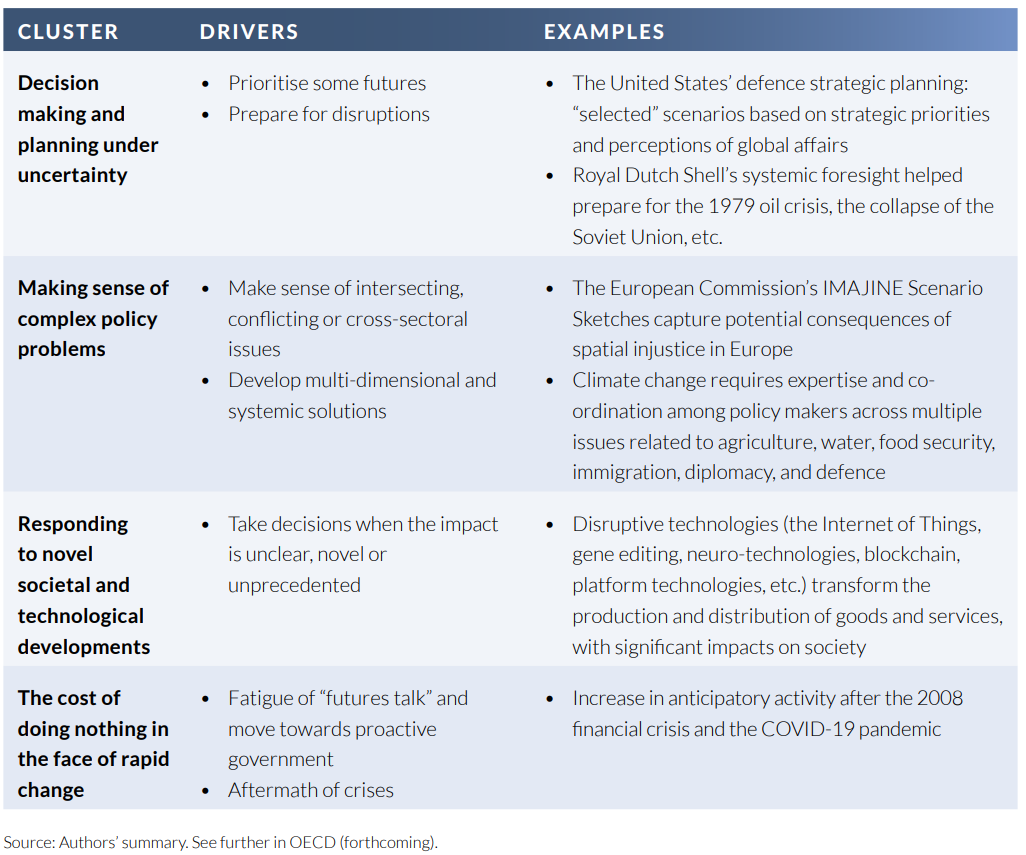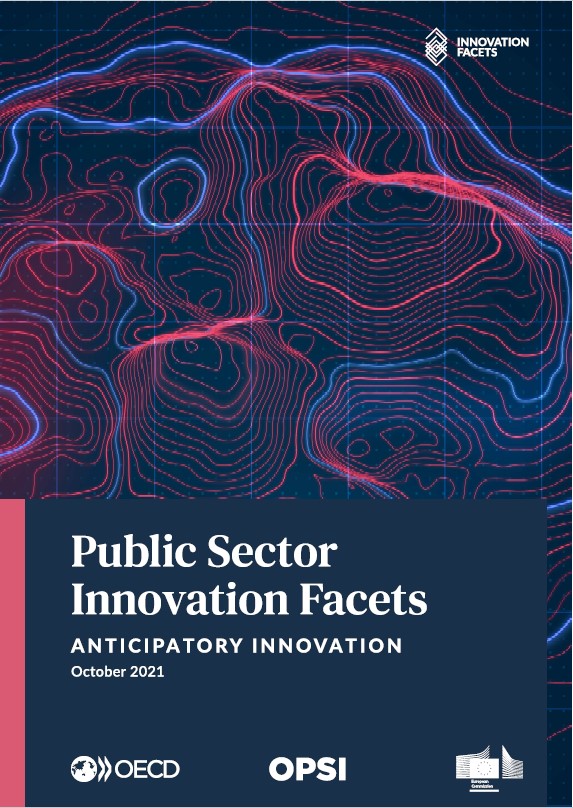Public Sector Innovation Facets: Anticipatory innovation

What is anticipatory innovation?
Anticipatory innovation is the act of creating and implementing new, value-shifting innovations in environments of deep uncertainty, particularly for the purposes of exploration and shaping future priorities. To facilitate anticipatory innovation in the public sector, governments require strong foresight ecosystems closely connected to innovation governance structures and working methods that embed anticipatory innovation in day-to-day processes. At its core, anticipatory innovation works to make future knowledge actionable by implementing real innovations based on empirical experimentation.

The Netherlands Armed Forces Futures: Scenarios in action
The Dutch Ministry of Defence has a long tradition of foresight activities. The report “Defensievisie 2035” outlines principles for action to prepare the armed forces for possible futures. As part of this process, the Ministry created scenarios with a time horizon of 2025. These scenarios are intentionally fictional but with a strong plausibility and impact potential. From these exploratory, contextual scenarios, some potential future situations were derived, and analysed for the capacities and preparedness they would demand of the Dutch armed forces. As in all effective foresight processes, the scenarios themselves are less important than the insights derived from them.
???????? The Netherlands
The challenge
To make policy is to think about the future. Every policy designed and delivered carries implicit or explicit notions of the context in which it will be implemented, the intended consequences and its potential effectiveness. Often these notions are based on expectations, forecasts, predictions and assumptions – mental models – about what the world will look like and how it will work. These mental models are not well suited to situations of volatility, uncertainty, complexity and ambiguity because they project the future in a linear manner that is not reflected in reality. New forms of innovation governance are needed to allow policy makers to respond to unforeseen events and technological change in real time.
Main drivers and support structures of anticipatory innovation
Anticipatory innovation is driven by a mix of factors which push organisations to step away from the comfort of the present and illuminate the need to act on signals of change. OECD research has identified the following main drivers of anticipatory innovation in the public sector: the impetus to make sense of complex policy problems, the need to decide and plan under conditions of uncertainty, pressure to respond to novel societal and technological developments, and the cost of doing nothing in the face of rapid change.

Enabling Conditions are the framework that make anticipatory innovation possible. Enabling conditions for anticipatory innovation in the public sector include: action-oriented foresight ecosystems, anticipatory governance and tested working methods.
- Foresight ecosystems refer to the broader structures, institutions and capabilities in government related to future knowledge and foresight in which anticipatory innovation is situated.[7] Common features of the foresight ecosystem include: mainstreaming anticipatory innovation into everyday work through culture and behaviour, purposeful processes to generate futures knowledge for use in prototypes and experimentation, and structures and institutions which reward the practices of anticipatory innovation.
- Anticipatory governance approaches need to be embedded within the core architecture of government. In order to do things differently, policy makers need agency – ways to operationalise their actions combined with a belief in their ability – and an authorising environment that gives them the authority and legitimacy to challenge current values.
- Tested working methods and protocols for practicing and implementing anticipation, foresight and anticipatory innovation need to be integrated into government structures. The brief outlines a number of successful government interventions which can be used as inspiration.
Tools and methods
Anticipatory innovation requires a variety of tools for each stage of the process. Methods of forecasting and visioning are essential at the outset, followed by tools to develop imagination, frame strategies and generate action. Finally, specific tools are needed to evaluate anticipatory innovation in terms of success and learning.
Setting up anticipatory innovation
Indicators can help policy makers track events, spot trends and separate relevant information from noise. Forecasting and horizon scanning methods help to identify signals of change in the present and their potential future impacts. Visioning tools create a shared vision for the organisation or community and explore not just what may be plausible but also what are acceptable futures for individuals and communities.
Running anticipatory innovation
Anticipatory innovation requires developing, framing and acting on the information derived from futures knowledge. Signals of emerging future change can be further developed, often through the use of creativity and imagination to encourage speculation. Framing narrows down the possibilities in order to focus on the most significant out of many potential developments. Lastly, anticipatory innovation only makes sense if experimentation is followed by action on the ground.

From experimentation to action – Slovenia’s Future of the Public Sector
In collaboration with the Slovenian Ministry of Public Administration, the OECD Observatory of Public Sector Innovation developed scenarios to reframe assumptions and plans regarding Slovenia’s public sector human resources. It implemented the findings during a second phase through prototyping workshops. These stages helped to connect visions of desired future states with actions that can be taken at strategic points within the Ministry’s talent management competency.
???????? Slovenia
Evaluating anticipatory innovation
The benefits of foresight are often indirect, difficult to measure and rarely solely attributable to foresight interventions. The “mental” and “foresight maturity” models have been put forward by practitioners as the best way to observe the impact of strategic foresight changes and/or measure the benefits of strategic foresight initiatives.
Skills and capacities needed for anticipatory innovation
In order to make futures thinking a conscious discipline applied to policy making, the following skills need to be harnessed and established:
- Subject matter expertise
- Imagination
- Appreciation of emergence and complexity
- Leadership and implementation
- Communication
Policy relevance
The implementation of anticipatory innovation in policy and public service practice responds to a range of urgent governance issues. Firstly, high-quality policy-driven foresight is often underused in government. There are many foresight works which imagine possible future events, some of which may never come to pass but can nevertheless be used to help organisations better prepare. The issue is therefore not a lack of useful foresight, but rather a lack of use of foresight. Secondly, governments are generally known to be risk-averse, rule-driven and rooted in stable structures and predictable decision making. This means that government responses to transformative change are generally reactive at best. Practitioners of anticipatory innovation have therefore advocated for exploring innovative approaches, novel organisational arrangements, fresh leadership and new ways of thinking to change how the public sector operates and to remove existing barriers. Thirdly, new anticipatory innovation tools are needed to increase upstream engagement with technology developers and lead users.
This work received funding from the European Union‘s Horizon 2020 research and innovation programme under grant agreement No. 870913

Public Sector Innovation Facets: Anticipatory innovation
Published on 27 October 2021.
